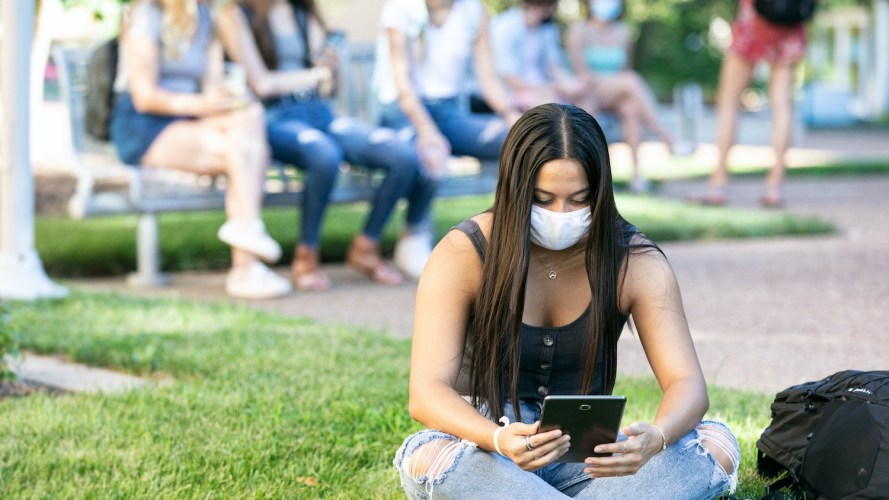Come fall, school administrators across the country will either welcome students back to campus or continue a virtual learning environment. While diligently reviewing recommendations and plans at the K12 or university level, schools have been working to adopt virtual learning since COVID-19 forced millions of students last spring to immediately leave campus. The University of Kentucky, a public research university with over 50,000 students, faculty, and staff, sprang into action to create a comprehensive plan to assess how it can safely and effectively bring its student and faculty populations back to its Lexington, Kentucky campus this fall.
Over three months, under the leadership of University President Dr. Eli Capilouto, a cross-departmental team comprising 500 faculty, staff, and students created a broad return-to-campus plan. In partnership with Salesforce, the university will assess the health and wellness of its campus community on a daily basis and enable contact tracers to manage the interactions of its students, faculty, and staff.
Capilouto sees this not just as a solution to get through COVID-19, but as an investment to come out on the other side stronger, using the platform as a springboard for a healthier community, supporting student mental health and well-being, reviewing and reworking social issues around diversity and inclusion, and preparing itself for the next crisis.
The 500 people making up 19 workstreams — from dining and housing to IT and health care — ultimately created the University of Kentucky Playbook for Reinvented Operations, which outlines a meticulous plan to safely reopen the sprawling campus. The plan will utilize many Salesforce tools, including Health Cloud, Lightning Platform Starter, Command Center, Education Cloud, surveys and digital engagement to allow for transparency, keeping everyone connected and informed about the latest university actions. Capilouto sends a twice-weekly campus-wide message to offer updates and keep spirits up around campus during what is likely to be a difficult time for many. But first, the university has to bring everyone to campus.
Returning in August
While staff and faculty will start returning to campus in mid- to late July, students will begin their semester on August 17. All students will receive a screening, testing and tracing to accelerate restart, and transition (START) kit with pertinent information, instructions, and personal protective equipment (PPE) including face masks and hand sanitizer. In addition, the school will provide all students with initial viral testing, prior to arriving on campus or during the first week after returning. The intent, of course, is to reduce the level of asymptomatic spread of COVID-19 around campus.
Once on campus, everyone will be required to use an app, currently under development with Salesforce technology, to self-assess and record daily whether they show any symptoms, based on the most current Centers for Disease Control and Prevention (CDC) recommendations. To assist this process, wellness stations set up around campus will offer additional information, PPE, and offer more health assessments.

In-person classes will require students to wear masks and practice
social distancing [Photo: courtesy of University of Kentucky]
Student life
One of the major reasons the university seeks to bring students back to campus is to retain that all-too-important culture and experience of college life. The school felt since incoming freshmen were already stripped of a typical graduation ceremony from their senior year of high school, they wanted to do whatever is possible to prevent a similar experience upon entry into college life. Life will, of course, look different for all students.
To alleviate too-close quarters, every student will get his or her own bedroom. So a residence hall room designed for two will hold one; one designed for four will hold two. In addition, only two people will be allowed to use the residence hall bathroom at any given time. And everyone will be required to wear masks at all times when not alone in a room, eating, drinking, or exercising.
Residential dining will operate at reduced capacity and move from self service to served stations. Social distancing measures — including queueing up around campus; washing hands; coughing and sneezing etiquette; and more — will be recommended and required in certain situations. Classrooms will reduce occupancy to 25% and learning situations that require in-person attendance, like laboratory sciences, may have extended hours to accommodate all students safely via shifts.
The school will break at Thanksgiving and conduct finals online. This will ensure the campus population won’t leave for a short period, connect with many who are not in the school ecosystem, and return to possibly infect others. An extended winter break will ensure safety for everyone. The workstreams focusing on restarting university life for this fall will continue working on this issue through the end of the year, using lessons learned while bringing everyone back together, so they can pivot where necessary.
Salesforce partnership
University of Kentucky was already using Salesforce.org Education Cloud for constituent relationship management, communications for prospects, students, and alumni, which made part of this transition much easier.
“We are taking a platform we’re comfortable with and applying it to a need we have right now,” says Chief Information Officer Brian Nichols. “We have the ability to do all the things through the customer relationship management (CRM) tools that we can use in screening and deploy messaging depending on the outcome. The fact that Health Cloud is compliant [in securing patient data to meet HIPAA standards] is huge. It offers us comfort. We have a partner that can ensure that important data is kept secure.”
Being nimble like a corporation
One reason the university could so quickly spring into action was because the team realized it needed to think more like a corporation.
“You can involve a lot of people in the process, but can still be nimble,” says Chief Communications Officer Jay Blanton. “It’s principle driven. What are the business objectives we need to achieve? You start there and design the process around that. We’re about people and ideas and you can involve a lot of that, but still be nimble and pivot.”

The university says the safety of its campus population is of
utmost importance [Photo: courtesy of University of Kentucky]
Looking toward the future
While the university has taken every possible precaution to ensure the safety of its campus population, they realize nothing is guaranteed. The playbook task force created a contingency plan in the event school needs to once again shut down and shift to online learning. School officials will watch the virus closely and continually consult with state officials while monitoring state and federal guidance. The university’s chief principle is the health, safety, and well-being of the campus community, which informs all its actions.
Classrooms have been equipped with more technology to accommodate virtual learning environments. If the university needs to pivot quickly, tools and technology for offsite learning are already in place to make that happen faster and better. Ninety percent of the university’s centrally assigned classes already have technology in place to provide online learning. In addition, in recent years, the school developed approximately six million square feet of new space, which is adaptable to different learning environments. In the last two years, incoming first-year students were all given iPads. And when the school shifted to online learning last spring due to the coronavirus shut down, the university’s information technology team shipped hundreds of mobile hotspots to students in need of Wi-Fi to access courses.
University of Kentucky also sits in a fortuitous position in that it’s one of eight institutions in the country that has all of its programs under one contiguous campus, including health and testing, which allows for easier ability to contact trace and quarantine. It can use its plan as a model or incubator lab to help the greater Kentucky population. University of Kentucky’s START team and its research alliance continue to meet to specifically work on clinical trials and other interventions in this space. The START group is also charged with looking at what scaling up a model for communities and industry for testing, tracing, and screening might look like; that’s still in the early stages. And the school maintains close conversations with the Commonwealth of Kentucky for potential data integrations, lessons learned and best practices.
“We don’t want to just get through this, but get through it and be smarter, better and more nimble at what we do,” says Chief Marketing Officer Julie Balog. “It’s important to solve the problem with COVID in screening, testing and tracing, but how else can we leverage this? We want to be a better university.”
To help educational institutions thrive, visit work.com for EDU.




























